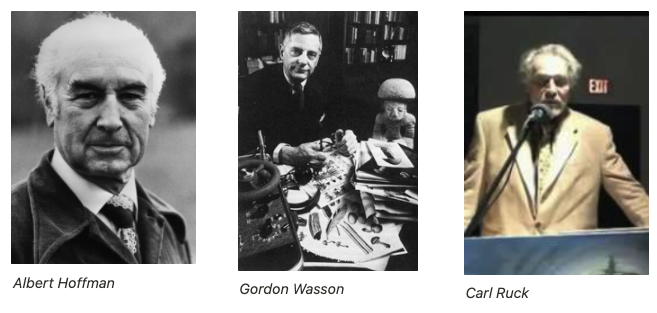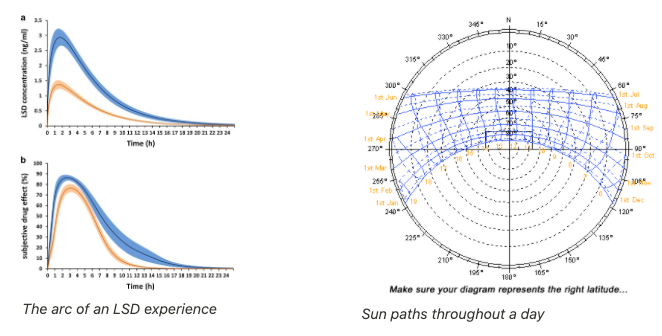🌿 On-Demand Resurrections
For centuries, historians have been trying to crack a mystery at the center of an Ancient Greek religion. Turns out, psychedelics may have been involved. It could change the nature of what we think about the Resurrection.
Solving the Eleusinian mystery
In 1978, a chemist, a historian, and an antiquity scholar shed light on an ancient Greek mystery. What was the source of the visions behind an Ancient Greek mystery school? Thousands of initiates returned from a ritual and claimed to have overcome their fear of death. They had a new perspective on life. The theory is that the Ancient Greeks extracted the toxic properties of an ergot fungus, and created a hallucinogenic brew that priests administered in a state-sponsored ritual. Crazy.

From the Minoan times to early Christianity (~300 AD), there was a festival centered around the myth of Persephone. She was a young Goddess who was captured by Hades and brought to the underworld. This bi-annual festival was known as the Eleusinian Mysteries. In addition to the wider celebration, each citizen could apply to take part in a smaller secret ritual. They could only do it once in their life. It involved 6 months of training in Athens, and concluded in a week-long secret initiation during the climax of the festival. The citizens returned as "epoptes," which translates to "ones who have seen the vision."

Still unanswered
There are many reason why the Hoffman, Wasson, Ruck's theory on psychedelic use at Eleusis is plausible. I will let you look up Road to Eleusis if you're interested. But I'm more interested in one of the holes in their theory that is unsolved.
How could over 1,000 people enter a temple, take a psychedelic, and then leave, with each participant coming away with a life revelation of a similar nature? According to Grof, psychedelics are "non-specific" amplifiers of the unconscious. Two individuals in the same setting can have radically different trips. Even the same person has different experiences from session to session. How did the Greeks pull off a ritual like this at this scale?
This question was the basis of an architectural thesis project of mine in 2013. The answer, might lie in building and ritual design, it might shape the future of psychedelic therapy.
The architecture of ritual
The unpredictable effects we've come to expect around psychedelics are often because there is so little preparation. The "set and setting" are typically loose. Set is the mindset going into an experience, and setting is the external stimuli during an experience.
MAPS (the Multidisciplinary Association of Psychedelic Sciences) is starting to prove (formally) how preparation can affect the outcomes of a trip. A 10-week psychotherapy program before tripping can systematically help people quite smoking, fight depression, overcome PTSD, and ease the anxiety of a terminal illnesses. The effects are in the realm of magic and miracles. They're working to reschedule psychedelics so that they can be administered in medical settings.
But what if the preparation leading up to a trip were religious in nature, instead of psychotherapeutic? That's what happened at Eleusis. Eleusis is a case study in controlling "set and setting" as tightly as possible, with the goal of inducing a resurrection experience.
Leading up to the psychedelic experience in the Telesterion, initiates would consume media (plays, poems, stories, songs), and act in plays around the myth of Persephone. They did this for months. They had to memorize texts and learn secret handshakes. It was almost like pledging for a fraternity, except it was sponsored by the Greek government, run by a class of seclusive monks, and no alcohol was allowed.
Embedded in these stories were symbols, each with specific emotional charges. These symbols were planted in the subconscious minds of the initiates (yes, like Inception). Usually, when groups enter a psychedelic experience together, each person comes in with different baggage. But the strict nature of their preparation meant everyone entered the gates of Eleusis with the same "set." While everyone had a different background, they were programmed identically, and ready to receive what was about to happen.

Within the gates of Eleusis, symbols from their training began appearing in real-life. Architecture was used to manifest symbols in the real-world. The statues, buildings, details, spaces, and actors had a new dimension of meaning to the initiates. They held an uncanny sense that they were living within the myth. The setting was intentional. It was designed for someone with a specific set.

On the night of the experience, the "Kykeon" was drank in the context of a culminating ritual. It was a brew, but only the priests knew that it had hallucinogenic properties. After ingestion, there was a dramatic build-up, where the story of Persephone was acted out in a "Sleep No More" style immersive ritual. It lasted for around an hour to give the psychedelic time to take effect. When the initiates entered their "peak state," the priests orchestrated the climax.
Gongs were hit and sound reverberated around the temple. A wall was shifted, and light entered the dark space in a mysterious way. Then the priest(s), in an eerie falsetto voice, began chanting, something along the lines of "Persephone has returned from the Dead." At this point, each of the initiates may have shared a common hallucination. They may have visualized Persephone in the room, as a hallucination (but without knowing it was a hallucination), and it had tremendous emotional charge. There were rumors that a "phantasma" was encountered in the temple, which now makes sense if we understand it in this way.
If the Hoffman, Wasson, Ruck hypothesis is correct, then it also means that the Greek heirophants (priests) were able to fuse art, architecture, myth, theater, and the science of psychedelics, to systematically guide the visions of large groups. The purpose of their theory and book was to argue: "See? The Greeks had psychedelics, we can have them too!" But they missed the biggest implication of their theory: that the Ancient Greeks possessed a historically unrecorded knowledge of the science of "summoning" resurrection experiences at scale.
What do we do with this knowledge?
Eleusis is a case study in how an external environment paired with symbolic preparation can shape psychedelic odysseys. The question is, where is the line? How much control should a gatekeeper exert?
A conservative (and scientific) application would be to come up with "principles for the design of psychedelic therapy institutions." There are a variety of non-specific ways that we can shape buildings to help with psychedelic therapy. For example, one trick is to coordinate the arc of an LSD experience with the path of the sun throughout the day. You can design a room in a way so that when someone is peaking, the room is dark and moody, but when they are coming down and integrating, the room is filled with mysterious light.

The other approach is to integrate what we know from Eleusis into existing religious constructs. The closest branch of religion we have is Greek Orthodox Christianity. It's actually very possible that Greek Orthodox rituals directly descend from the Eleusinian Mysteries, but with the Kykeon ingredient removed from the communion wine. The Greek Orthodox Easter week is a seven day ritual, each day with specific songs and stories, and concludes in a midnight ritual with masses, the sound of bells, the light of candles, and a priest chanting, "Xristos Anesti" ("Christ has risen from the dead").
Christianity, (separate from the politics) already has a built-in symbology that is filled with emotionally charged symbols and themes of personal empowerment. It would be possible to design and build a church around the Greek Orthodox faith, but for the purpose of psychedelic rituals. This church could be paired with slightly modified versions of Lent, Easter Week, and the ritual going from Saturday night into Sunday morning.
The idea sounds crazy, but with a small group of 10 people, we could prove or disprove if it's possible to fuse architecture, art, myth, theater, and psychedelics to systematically resurrect Christ in the visual fields of ritual participants. A similar experiment was conducted in 1962 with psychedelics and Christians, but without a ritual built for a specific hallucination. I've also caught wind of a peyote cult in the American Southwest that frequents visions of the Virgin Mary.
Dean's List
Join to get new posts in your inbox.